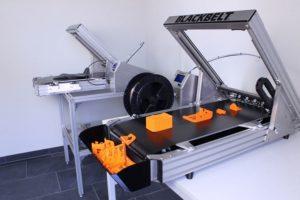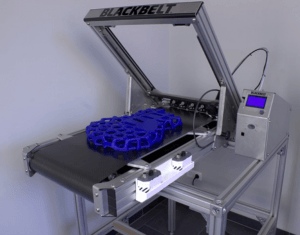 Typically, we see things like groceries fly by on conveyor belts, or even people, if your airport features that large moving sidewalk in the middle of the terminal. In a couple days, the website for an innovative new FDM 3D printer will go live: the BlackBelt, a new kind of industrial production machine, was designed to turn ideas into reality at a low cost, in a short time frame, using a conveyor belt. We’ve seen conveyor belt 3D printing systems before, mainly when combined with robotics, but nothing quite like this. FDM 3D printers are now essential machines for a lot of companies, having been developed into reliable production units, but BlackBelt 3D’s printer is something altogether different. The goal was to make an FDM 3D printer that was as easy to use as a 2D printer is with paper.
Typically, we see things like groceries fly by on conveyor belts, or even people, if your airport features that large moving sidewalk in the middle of the terminal. In a couple days, the website for an innovative new FDM 3D printer will go live: the BlackBelt, a new kind of industrial production machine, was designed to turn ideas into reality at a low cost, in a short time frame, using a conveyor belt. We’ve seen conveyor belt 3D printing systems before, mainly when combined with robotics, but nothing quite like this. FDM 3D printers are now essential machines for a lot of companies, having been developed into reliable production units, but BlackBelt 3D’s printer is something altogether different. The goal was to make an FDM 3D printer that was as easy to use as a 2D printer is with paper.
“The idea behind this concept was to bring 3D printers closer to the same level where 2D printers are nowadays,” Stephan Schürmann, BlackBelt 3D BV, told 3DPrint.com. “The BLACKBELT has been under development for some years now. The date for the release will be published, together with our website on Friday! Right now, there is no official cooperation with other companies, but we are always looking for people from the industry, that want to apply this technology in their production process.”
 Many of the printer’s parts and components are standard, like the X-Y actuation system. But with the BlackBelt, the assembly has been slanted to a specific 45°, and the printer’s high-precision conveyor belt is the new Z-axis and print platform, moving horizontally with each new layer. That belt allows the print to adhere, and precisely position itself, as it’s made from well-tested carbon fiber composite.
Many of the printer’s parts and components are standard, like the X-Y actuation system. But with the BlackBelt, the assembly has been slanted to a specific 45°, and the printer’s high-precision conveyor belt is the new Z-axis and print platform, moving horizontally with each new layer. That belt allows the print to adhere, and precisely position itself, as it’s made from well-tested carbon fiber composite.
 The printer has a customizable, modular design, which can be modified to fit the user’s various needs. The frame construction uses BOSCH Alu profiles, and rigid, stainless steel sheet-metal parts, so it can be adapted for either an industrial or a desktop printing environment. It’s available as a standalone or as a desktop version; the former can be used in conjunction with an optional downstream roller table, so it can support very long products while printing. The BlackBelt has three separate print heads with user-friendly, easily exchangeable nozzles; though more sizes will be available later, right now there are options for 0.4, 0.6, and 0.8 mm.
The printer has a customizable, modular design, which can be modified to fit the user’s various needs. The frame construction uses BOSCH Alu profiles, and rigid, stainless steel sheet-metal parts, so it can be adapted for either an industrial or a desktop printing environment. It’s available as a standalone or as a desktop version; the former can be used in conjunction with an optional downstream roller table, so it can support very long products while printing. The BlackBelt has three separate print heads with user-friendly, easily exchangeable nozzles; though more sizes will be available later, right now there are options for 0.4, 0.6, and 0.8 mm.
Other specifications for the BlackBelt include:
- Industrial linear guides
- Build volume of 13″ x 13″ x infinity
- Adjustable print angles: 45° is the default, but some parts come out better at the lower angles of 15°, 25°, and 34°
- 1.75 mm filament diameter
- €9,500 for desktop version, €12,500 for large system with standing supports
 Thanks to its open build volume, the BlackBelt is able to support large format 3D printing, and can also print extremely long parts; theoretically, these prints can have an endless length. For parts that are 1300 mm or longer, BlackBelt 3D recommends that users provide extra support during the printing process with the roller table. The BlackBelt is helpful for series production, as it can continuously print one part after another. This is where the conveyor belt comes in handy: instead of removing the prints, just put a container in front and it will collect them! Additionally, the BlackBelt allows users to set a specific print angle so support-free overhangs can be printed on slanted geometry.
Thanks to its open build volume, the BlackBelt is able to support large format 3D printing, and can also print extremely long parts; theoretically, these prints can have an endless length. For parts that are 1300 mm or longer, BlackBelt 3D recommends that users provide extra support during the printing process with the roller table. The BlackBelt is helpful for series production, as it can continuously print one part after another. This is where the conveyor belt comes in handy: instead of removing the prints, just put a container in front and it will collect them! Additionally, the BlackBelt allows users to set a specific print angle so support-free overhangs can be printed on slanted geometry.
- Long parts
- Series production
- Support-free overhangs
The BlackBelt 3D printer enables users to create new shapes that aren’t possible on standard XYA printers, but there are some guidelines to go along with this capability. As mentioned previously, while print jobs can be completed without additional support material, some designs and parts will need a starting geometry, so nothing prints in the air. Every new geometry needs to begin either on a previous layer, or on the conveyor belt, to avoid extruding material into the air. From here, the part can go towards the machine (the Z direction) or up in the air (the Y direction).
Many geometries, which would typically need supports, can now be produced without them; this saves time, and building material, which in turn saves money. A 45° print angle works for most shapes that require supporting geometry at the start, but some shapes will need a lower angle for better printing, such as printed overhangs that tilt away from the printer.
 There are several potential applications for the BlackBelt 3D printer, like printing signs and displays for companies in a single print job; the BlackBelt 3D team notes that multiple functionalities can be added to objects like this, such as mounts. Extruded profiles match the BlackBelt 100%, making it possible to print objects like flexible seals and hollow tubes. High volume production is also possible with the BlackBelt. Large series of specific products are possible once the design criteria are met, thanks to the printer’s conveyor belt; check with the BlackBelt 3D team to see if your company’s product is a match.
There are several potential applications for the BlackBelt 3D printer, like printing signs and displays for companies in a single print job; the BlackBelt 3D team notes that multiple functionalities can be added to objects like this, such as mounts. Extruded profiles match the BlackBelt 100%, making it possible to print objects like flexible seals and hollow tubes. High volume production is also possible with the BlackBelt. Large series of specific products are possible once the design criteria are met, thanks to the printer’s conveyor belt; check with the BlackBelt 3D team to see if your company’s product is a match.
On Friday, May 12, the BlackBelt 3D website will go live, and the team will announce the date of the BlackBelt 3D printer’s upcoming Kickstarter campaign. Stay tuned, as early bird backers will be able to get a significant price discount on the BlackBelt. Discuss in the BlackBelt forum at 3DPB.com.
[All Images: BlackBelt 3D]
Subscribe to Our Email Newsletter
Stay up-to-date on all the latest news from the 3D printing industry and receive information and offers from third party vendors.
Print Services
Upload your 3D Models and get them printed quickly and efficiently.
You May Also Like
Making 3D Printing Personal: How Faraz Faruqi Is Rethinking Digital Design at MIT CSAIL
What if your 3D printer could think more like an intelligent assistant, able to reason through a design idea, ask questions, and deliver something that works exactly the way the...
Reinventing Reindustrialization: Why NAVWAR Project Manager Spencer Koroly Invented a Made-in-America 3D Printer
It has become virtually impossible to regularly follow additive manufacturing (AM) industry news and not stumble across the term “defense industrial base” (DIB), a concept encompassing all the many diverse...
Heating Up: 3D Systems’ Scott Green Discusses 3D Printing’s Potential in the Data Center Industry
The relentless rise of NVIDIA, the steadily increasing pledges of major private and public investments in national infrastructure projects around the world, and the general cultural obsession with AI have...
Formlabs Teams Up with DMG MORI in Japan
In late June, Nick Graham, Chief Revenue Officer at Formlabs, announced on LinkedIn that the company had partnered with DMG MORI, one of the world’s leading machine tool companies, to...





































